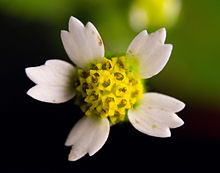| Galinsoga quadriradiata | |
|---|---|

| |
| Scientific classification | |
| Kingdom: | Plantae |
| Clade: | Tracheophytes |
| Clade: | Angiosperms |
| Clade: | Eudicots |
| Clade: | Asterids |
| Order: | Asterales |
| Family: | Asteraceae |
| Genus: | Galinsoga |
| Species: | G. quadriradiata |
| Binomial name | |
| Galinsoga quadriradiata Ruiz & Pav., 1798 | |
| Synonyms | |
Synonymy
| |
Galinsoga quadriradiata is a species of flowering plant in the family Asteraceae which is known by several common names, including shaggy soldier, Peruvian daisy, hairy galinsoga. Its native home is apparently central Mexico, although it has become naturalized in many other places (North and South America, Europe, Japan, Philippines, the northern India, Nepal, etc.).
Description
Galinsoga quadriradiata is an annual herb which varies in appearance. The main stem reaches anywhere from 10 to 60 centimeters (4-24 inches) in height and may branch or not. The petioled leaves are ovate and serrated are opposite branching, and covered coarse, hispid hairs. The roots form a fibrous root system.
The small flower heads are up to a centimeter wide (0.4 inches) but typically 2-3mm in diameter and have rounded center filled with many disc florets usually in a shade of bright yellow. There are typically five white ray florets widely spaced around the center, each an oval shape typically with three crenate teeth at the tip. Both the disk and ray florets are fertile producing an achene with a large pappus.
Identification
Shaggy soldier is usually a hairy plant, whereas the otherwise similar gallant soldier tends to be more-or-less hairless, but these characters are insufficient for accurate identification. To be confident, it is important to check (with a hand lens) that shaggy soldier has simple (not forked) scales on the receptacle, and scales in the pappus with hairy margins and a long, thin point at the top.

Uses

Galinsoga quadriradiata and its cousin Galinsoga parviflora are both edible and can be used as a pot herb or in salads, although outside of their native range they have not been widely adopted as a culinary item other than in China. G. parviflora is preferred as a salad green due to its non-hairy leaves. Care must be taken to not confuse them with the distantly related, and visually similar, Tridax procumbens.
References
- The Plant List, Galinsoga quadriradiata Ruiz & Pav.
- NRCS. "Galinsoga quadriradiata". PLANTS Database. United States Department of Agriculture (USDA). Retrieved 19 January 2016.
- BSBI List 2007 (xls). Botanical Society of Britain and Ireland. Archived from the original (xls) on 2015-06-26. Retrieved 2014-10-17.
- ^ Flora of North America, Galinsoga quadriradiata Ruiz & Pavón, 1798.
- ^ Canne-Hilliker, Judith Marie. 1977. Rhodora 79(819): 353-364 in English, line drawing on page 354, around the world distribution map on page 359
- Rhoads, Block (5 September 2007). The Plants of Pennsylvania (2 ed.). ISBN 978-0-8122-4003-0.
- ^ "Peruvian daisy". Illinois Wild Flowers. Retrieved 8 November 2015.
- Flora of China, Galinsoga quadriradiata Ruiz & Pavon, 1798. 粗毛牛膝菊 cu mao niu xi ju
- Stace, C.A. (2019). New Flora of the British Isles (4th ed.). Suffolk: C&M Floristics. ISBN 978-1-5272-2630-2.
External links
 Media related to Galinsoga quadriradiata at Wikimedia Commons
Media related to Galinsoga quadriradiata at Wikimedia Commons- Jepson Manual Treatment
- "Galinsoga quadriradiata". Germplasm Resources Information Network. Agricultural Research Service, United States Department of Agriculture.
| Taxon identifiers | |
|---|---|
| Galinsoga quadriradiata |
|